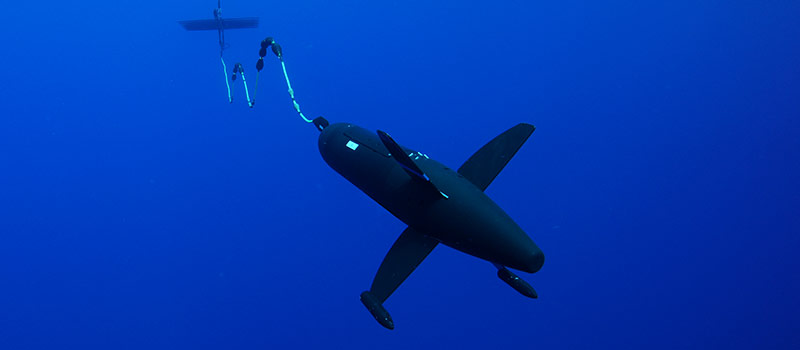Japanese robot swims for months in the ocean to detect tsunamis

The Japanese islands are located in an extremely seismically active zone. Earthquakes are frequent here, sometimes tsunamis occur, as a derivative of earthquakes, which leads to significant destruction of houses and industrial facilities in coastal zones. During natural disasters people die. Researchers from Kobe University decided to use a floating robot that could warn in advance about a tsunami. In this case, the early warning system would solve many problems, allowing residents of the region where the tsunami wave originated to evacuate before the wave appeared.
On the Japanese islands there are many zones where tsunamis are possible. One of these zones is the region of the volcanic island Nishinoshima, which appeared as a result of an underwater volcanic eruption only a few years ago - in 2013. Japanese researchers led by Hiroko Sugioka (Hiroko Sugioka) released the robot in free navigation. It is called Wave Glider. The system is equipped with a hydrophone, a camera and a communication module that allows the robot to keep in touch with the satellite.
Specialists of the Liquid Robotics company created the robot . It receives energy from wave energy and solar energy, which allows the robot to be on the water for months, he does not need fuel. At the bottom of the project authors placed sensors that track water pressure and magnetic field strength. The combination of certain values of these two factors is an indicator of a tsunami. The robot also receives information from its own sensors, transmitting information via satellite to the “mainland”.
')
Even with the use of a robot, people have very little time left to leave the area where the tsunami originated. From the moment of formation of conditions suitable for a wave to the moment of a tsunami strike on the coast, it usually takes about 3-4 minutes. This, in principle, is enough for people to find refuge on high ground.
One of the advantages of the robot, according to its developers, is the relatively low cost of both the robot and its maintenance. In Japan, there are other tsunami early warning systems — special buoys that form a network. They transmit information to earth via satellite. But to fix the buoys it takes many kilometers of special cables. In general, the creator of the robot claims that his invention will cost the budget about 10 times cheaper than installing buoys.

Buoys, by the way, is not the most accurate method for determining the occurrence of a tsunami. For example, in March 2016, an earthquake measuring 7.8 on the Richter scale occurred in Sumatra. The network of buoys was unable to obtain the necessary wave data for scientists, so experts could not understand how large the incipient tsunami wave became. As a result, the government ordered an evacuation. Hundreds of thousands of people left their homes to watch the tsunami from a safe distance. But the wave did not appear.
In Japan, the memory of an earthquake measuring 9 points, which caused massive destruction and death, is still fresh. The situation then (the disaster occurred in 2011) intensified due to the occurrence of a tsunami soon after the earthquake itself. The robot, according to Japanese scientists, has the ability to determine the appearance of a tsunami with a high degree of accuracy.
Tsunamis are long and high waves generated by a powerful impact on the entire water column in the ocean or other body of water. Most tsunamis are caused by underwater earthquakes, during which there is a sharp displacement (raising or lowering) of the seabed area. Tsunamis are formed during earthquakes of any force, but those that arise due to strong earthquakes (with a magnitude of more than 7) reach a large force. As a result of an earthquake, several waves propagate. More than 80% of tsunamis occur on the periphery of the Pacific Ocean.
The appearance of a tsunami is accompanied by a number of signs that are important not to miss. The main thing is a quick and sudden outflow of water from the coast for a long distance with the exposure of the bottom. Usually, the further the water recedes, the higher the tsunami waves. Residents of the Japanese islands, the Indian Ocean coast of Indonesia, Kamchatka know what to do in such cases - to get the maximum distance from the coast, trying to find an elevation. True, it also happens that tsunamis appear without water retreat. In this case, the giant waves are called teletsunami.
The causes of the tsunami have long been known - this is underwater earthquakes (85% of all tsunamis), landslides on the coast, volcanic eruptions, human activity (explosions of atomic bombs in the ocean).
Source: https://habr.com/ru/post/401219/
All Articles